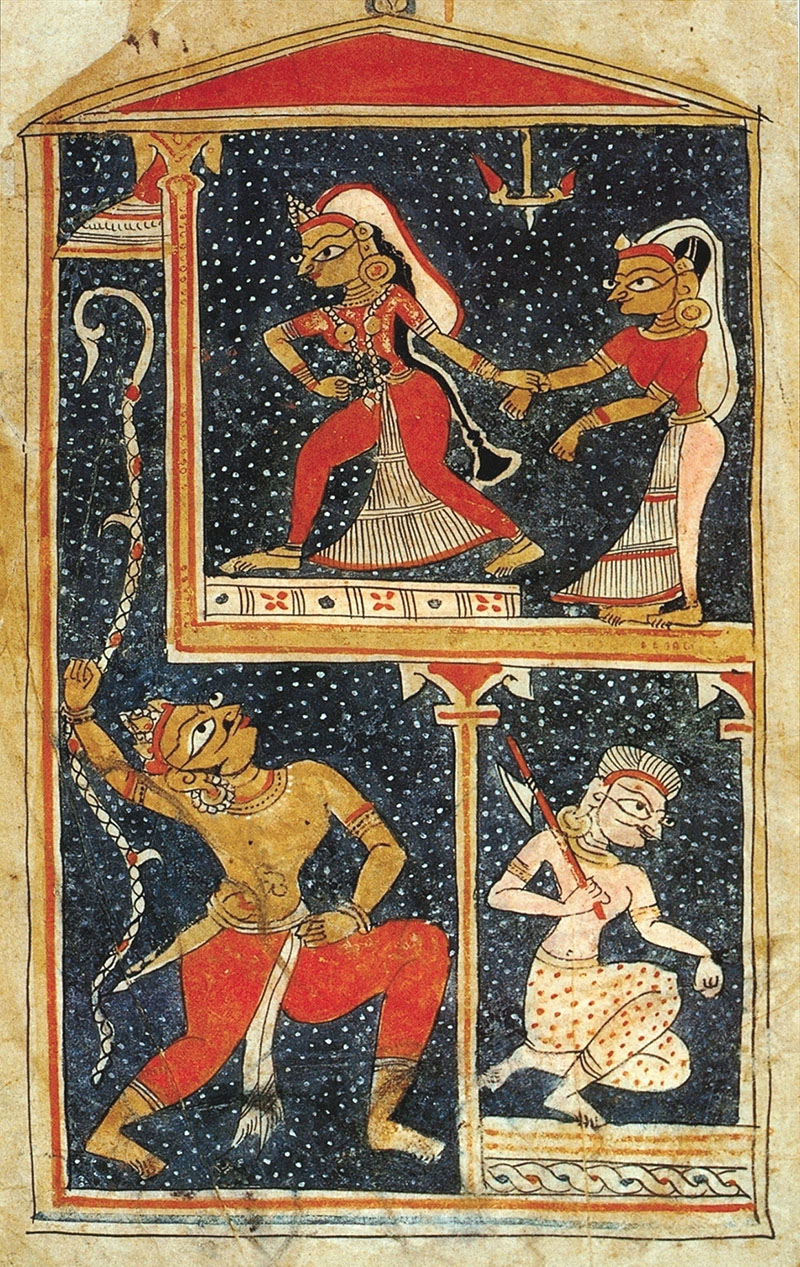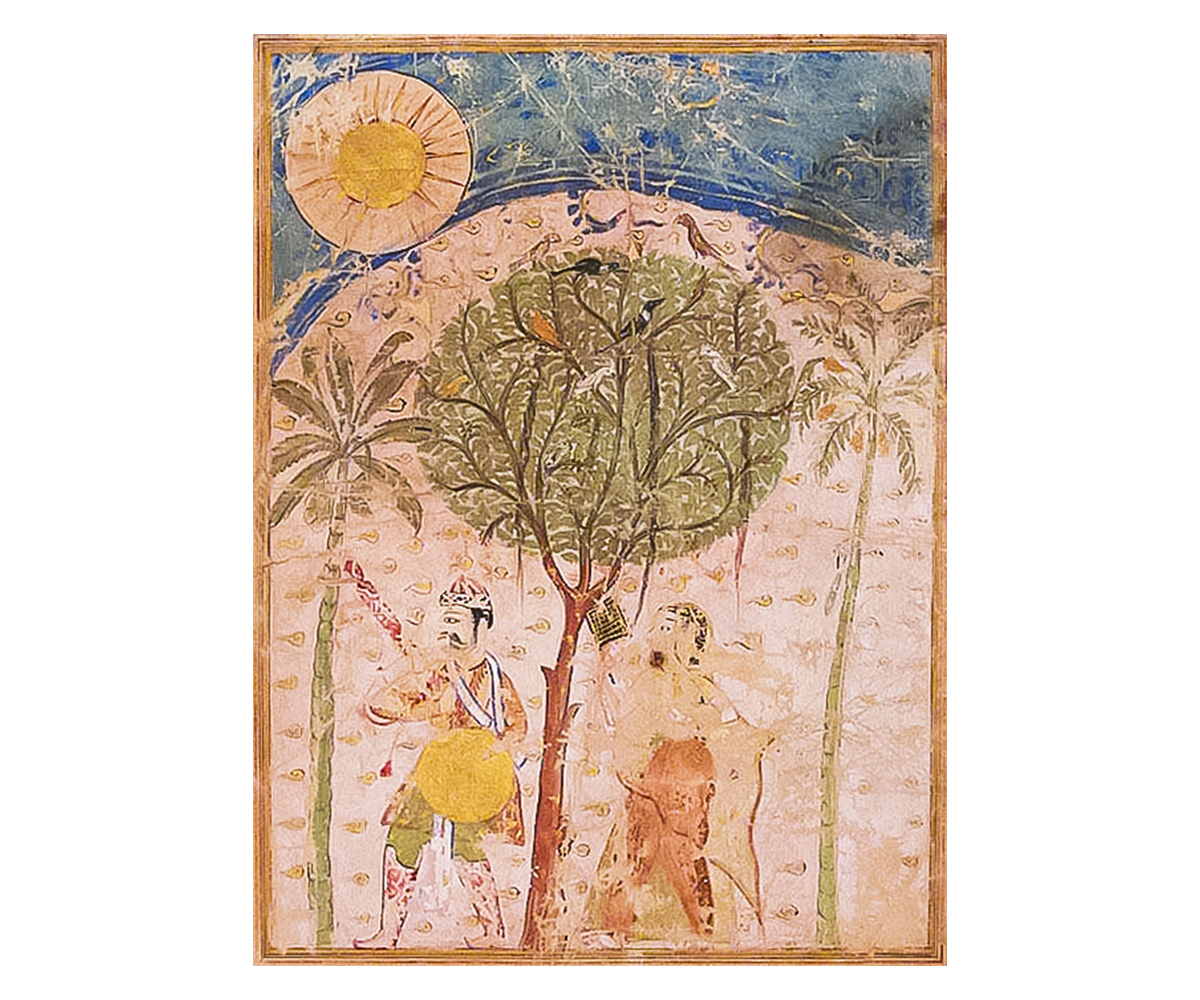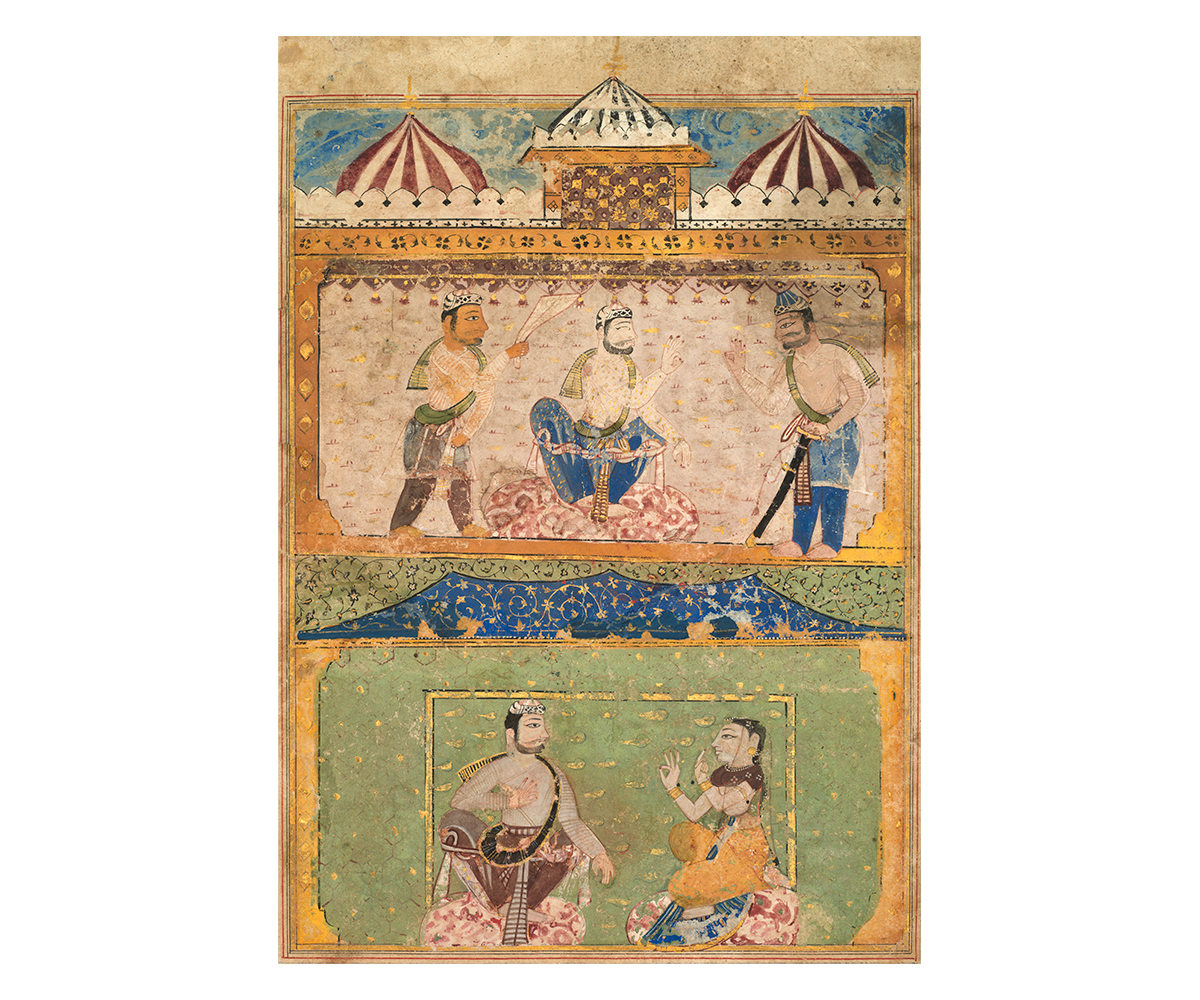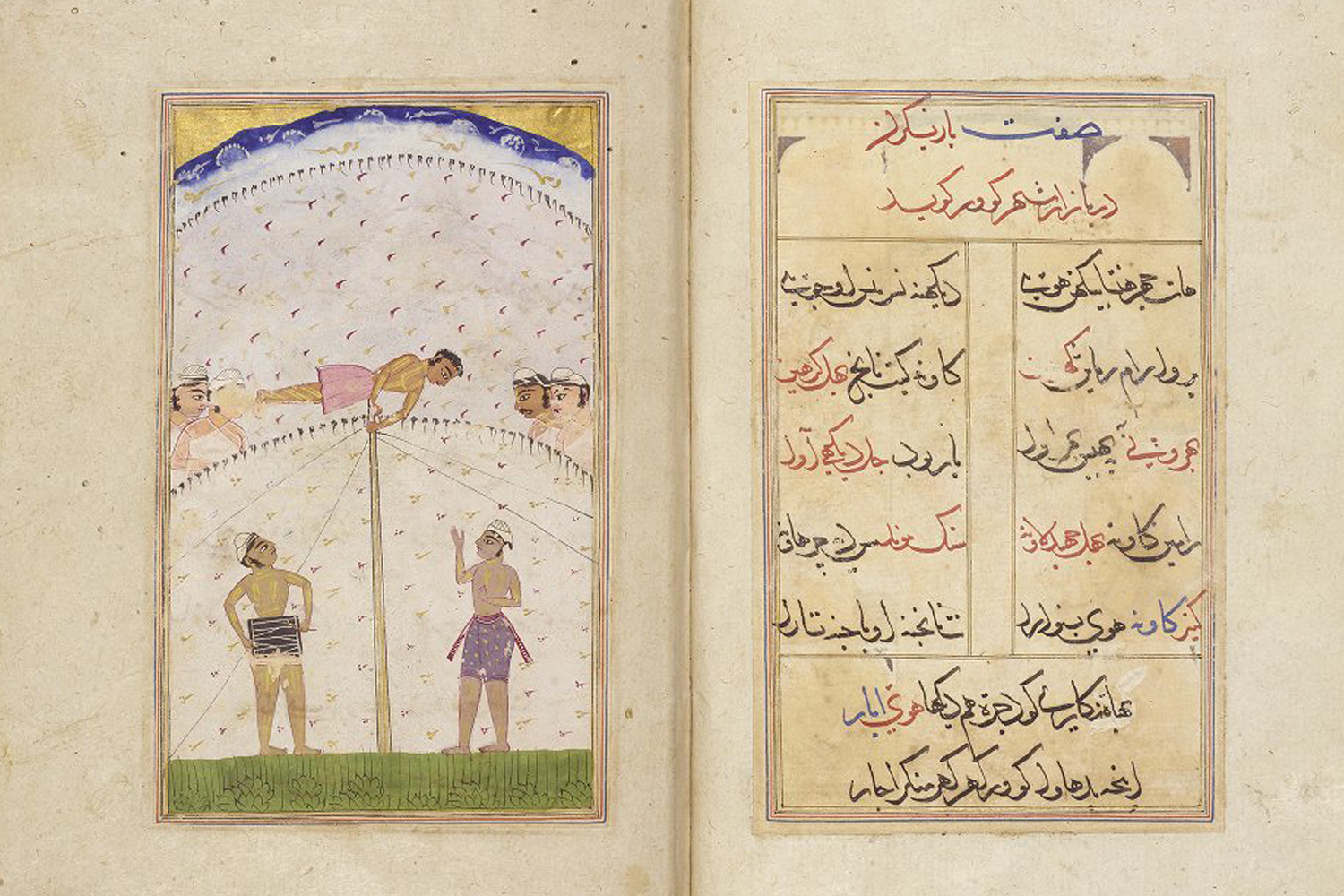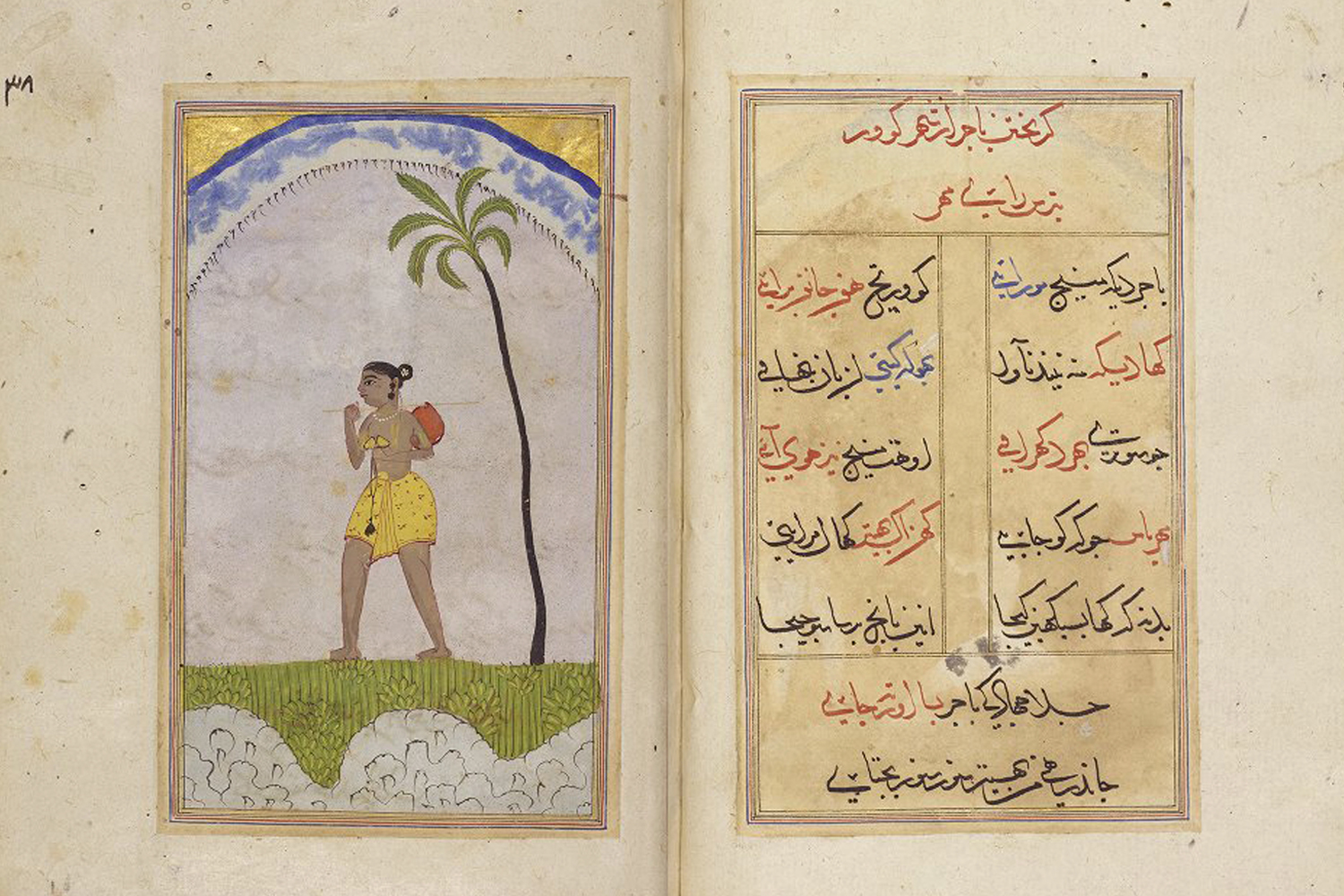ARTICLE
The Chandayana Manuscripts
Dated to 1450–70, the Berlin Chandayana is believed to be the oldest of the five manuscripts. The illustrations borrow visual elements from contemporaneous Jain manuscript painting and serve as precursors for the style of later Mughal manuscripts such as the Hamzanama and Shahnama. This is most notable in the depiction of the eye and torso in the figural form, spatial settings and the treatment of landscape and background details such as clouds. Scholars suggest that the manuscript may have been illustrated in Delhi or Jaunpur, while some have also associated it with Malwa. Given the influence of multiple visual sources from various regions in the illustrations, the artists are believed to have been travelling painters.
The Benaras Chandayana is stylistically similar to the Berlin Chandayana and may also date to the late fifteenth century. The colour palette of both manuscripts is limited, yet bold. A key difference is that all the registers of the illustrations in this manuscript are narrative, unlike those of the Berlin Chandayana.
The Lahore-Chandigarh manuscript displays several characteristics of the Chaurapanchasika style. The figural types, shown in profile, are the same for the male and female characters. Male figures are shown wearing costumes that were typically reserved for nobility and the elite at the time, such as kulahs, jamas and patkas (sash or wide belt), whereas female figures are depicted in everyday costumes such as cholis, ghagras and odhanis, with flared ends and tassels. While the architectural details reference Islamic influences in details such as domed pavilions, the treatment of landscape is seen as Indic, with the representation of easily recognisable, although stylised, trees and plants. This manuscript stands out among the other Chandayana texts in its depiction of a Muslim cleric in the upper register of every illustrated page, referencing Mulla Daud. Like the Berlin Chandayana, scholars attribute the illustrations to travelling artists on account of their familiarity with Hindu and Islamic visual elements as well as with the Chaurapanchasika style.
The limited colour palette of the Berlin, Benaras and Lahore-Chandigarh manuscripts is seen to evolve into a more varied one in the Mumbai and Manchester manuscripts. An evolution of the figural form is also seen, with features such as protruding eyes, squarish faces and lack of defined musculature giving way to faces in profile and well-proportioned bodies shown in frontal or three-quarter view. Action and expression are conveyed through postures and gestures. Borrowing and combining stylistic elements from Jain manuscript painting and Persianate painting, the illustrations have sparked considerable debate on the place of origin of these manuscripts.
The stylistically similar illustrations of the Mumbai and Manchester Chandayana manuscripts, both dated to the first half of the sixteenth century, are noted for the influence of Persian painting of the time. This is seen particularly in the use of a high horizon line in both manuscripts, and visual similarities to the Nimatnama-i-Nasiruddin-Shahi illustrated in Mandu, in Madhya Pradesh, c. 1500. For example, the illustrations of the Nimatnama and the Mumbai Chandayana manuscripts show similarities in composition and postures in the groupings of the central figures of Laur, Chanda and Ghiyath Shah, as well as in the motifs of textile patterns. The Manchester Chandayana shares commonalities with the Nimatnama in the treatment of the landscape and horizon line. Persianate architectural motifs, such as domed structures, are seen alongside an Indic style of representing flora and fauna, as seen in the rendering of foliage and birds. Scholars have also noted the figural forms in the Mumbai Chandayana to be similar to those in the Lahore-Chandigarh manuscript, though they lack the angularity of the latter. In addition to its colour palette, comprising pastels and pinks, the Mumbai Chandayana is also noted for the detailing of motifs in tile patterns, textiles and architecture.
The Manchester Chandayana is chronologically the last known illustrated version of the text and has the most illustrations among the surviving versions. It is distinct among the five Chandayana manuscripts in its liberal use of gold and silver in the illustrations and its depiction of complete structural forms of architecture in single spatial registers. Figural depictions are shown in profile or three-quarter views, with a degree of tonality used for male forms. The use of gold and silver has led some scholars to suggest that the manuscript may have been a deluxe version. With the gold highlighting for the horizon line, the illustrations resemble Deccan paintings of the same period. The Mumbai and Manchester Chandayanas’ proximity in style with the Nimatnama and Deccan painting has led scholars to suggest that they may have been produced in central India or the Deccan region, where both Persian artistic influences and Sufism were patronised.
Individual folios of Chandayana manuscripts are also part of public and private collections and institutions such as the Metropolitan Museum of Art and the Brooklyn Museum, New York, and the Cleveland Museum of Art.
Bibliography
Adamjee, Qamar. “Strategies for Visual Narration in the Illustrated Chandayan Manuscripts.” PhD diss., New York University, September 2011.
Chari, Mridula. “When Sufi Poet Composed One of India’s Earliest Love Stories in Hindi.” Scroll.in, December 28, 2015. Accessed May 25, 2023. https://scroll.in/article/772207/when-a-sufi-poet-composed-one-of-indias-earliest-love-stories-in-hindi.
Flood, Finbarr Barry. “Before The Mughals: Material Culture Of Sultanate North India.” Muqarnas 36 (2019): 1–39. https://www.jstor.org/stable/26835430.
Goswamy, B. N. “Master of the ‘Laur Chanda’ Series.” Artibus Asiae, Supplementum 48 (2011): 89–96. http://www.jstor.org/stable/23220220.
Goswamy, B. N. The Spirit of Indian Painting: Close Encounters with 101 Great Works 1100–1900. New Delhi: Penguin Random House India, 2014.
Losty, Jeremiah P. The Art of the Book in India. London: The British Library, 1982.




